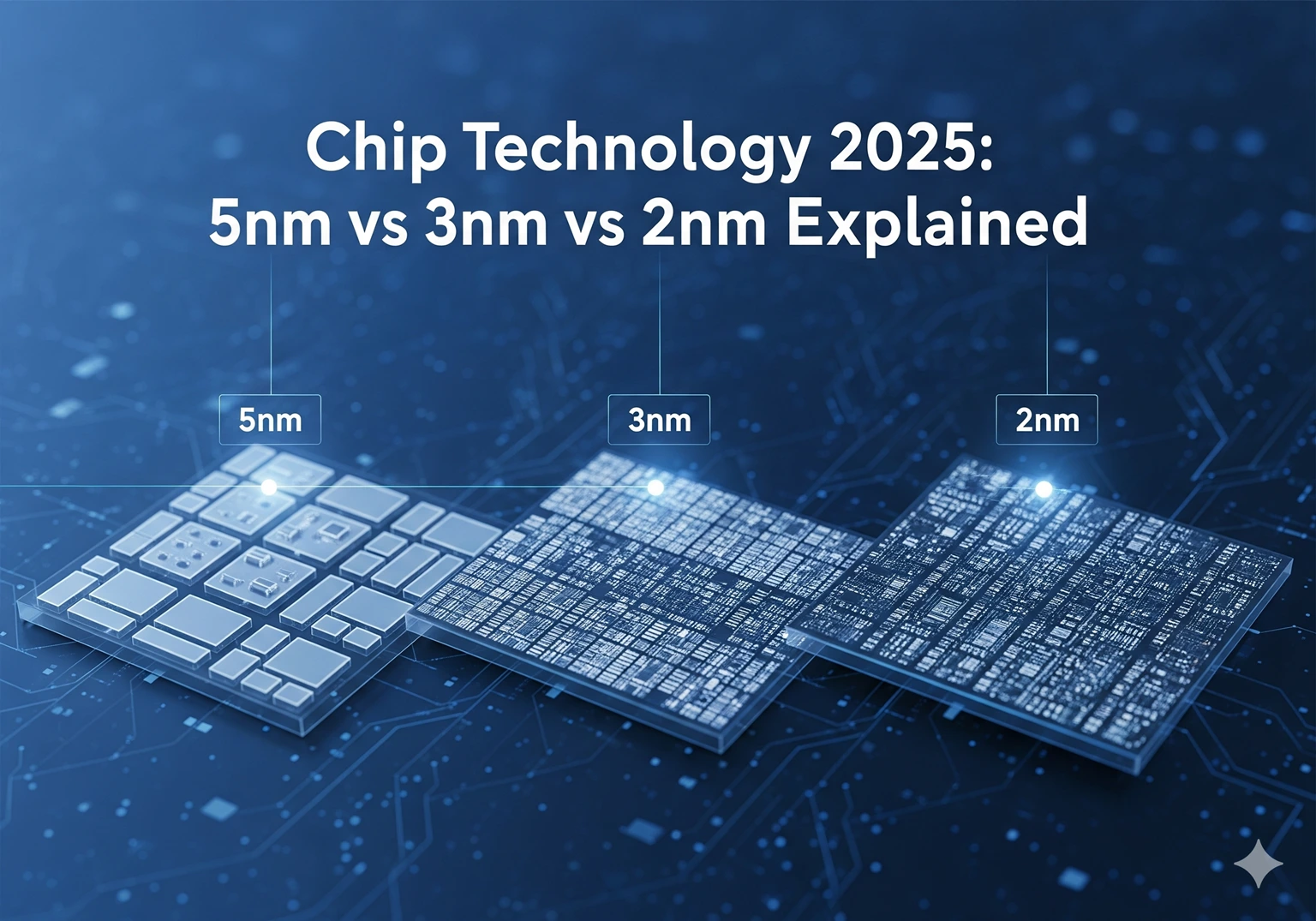Introduction
In 2025, comparing 5nm vs 3nm vs 2nm chip technologies reveals how semiconductor innovation shapes smartphones, laptops, AI systems, and data centers. These process nodes are not just marketing labels—they represent generations of manufacturing technology that determine how powerful, efficient, and compact modern processors can be.
If you’ve ever wondered about the differences in 5nm vs 3nm vs 2nm chips, this article breaks it down in simple terms. We’ll compare their performance, efficiency, transistor density, and future applications so you can clearly understand where the chip industry is heading.

What Does “nm” Mean in Chip Technology?
The term “nm” (nanometer) refers to the size of features on a semiconductor. Traditionally, it described the length of the transistor gate, but today it’s more of a marketing name for each new process node, like 5nm vs 3nm vs 2nm.
- Smaller nm values = more transistors packed in the same area.
- More transistors = higher performance and lower power consumption.
- Each new generation requires advanced manufacturing techniques, such as Extreme Ultraviolet Lithography (EUV) and soon Gate-All-Around (GAAFET) technology.
Evolution of 5nm, 3nm, and 2nm Chips
| Process Node | Year of Adoption | Example Devices | Transistor Density (approx.) | Key Features |
|---|---|---|---|---|
| 5nm | 2020–2022 | Apple A14, M1, Snapdragon 8 Gen 1 | ~171M / mm² | Efficient, mainstream in phones & laptops |
| 3nm | 2023–2024 | Apple A17 Pro, M3, Snapdragon X Elite | ~300M / mm² | ~35% power efficiency gain vs 5nm |
| 2nm | 2025–2026 (expected) | Future Apple/TSMC/IBM chips | ~333–450M / mm² | Uses GAAFET, 25–30% faster or 50% less power |
5nm Chips: The Current Standard in 2025
5nm chips marked a turning point in consumer technology. They first appeared in 2020 smartphones like the iPhone 12 (A14 Bionic) and later expanded into laptops (Apple M1) and high-end Android devices, setting the stage for 5nm vs 3nm vs 2nm comparisons.
Key Benefits of 5nm Technology
- Performance boost over 7nm with ~20% speed improvement.
- Energy efficiency made laptops last longer on battery.
- Mass adoption by TSMC and Samsung, powering billions of devices.
In 2025, 5nm is still widely used in mid-range smartphones, laptops, and IoT devices, even though 3nm and 2nm are entering premium markets.
3nm Chips: Leading the 5nm vs 3nm vs 2nm Race
3nm chips became reality in 2023, with Apple’s A17 Pro and M3 chips being the first mass-produced processors at this node.
Advantages of 3nm Technology
- Up to 15% faster performance vs 5nm.
- Up to 35% better power efficiency, crucial for longer battery life.
- More transistors per mm², allowing AI and graphics accelerators to be integrated more effectively.
Real-World Examples of 3nm Chips
- Apple A17 Pro → powers the iPhone 15 Pro, offering smoother gaming and improved AI processing.
- Apple M3 chips → laptops with more power while consuming less energy.
- Qualcomm Snapdragon X Elite → designed for Windows laptops, rivaling Apple Silicon.
In 2025, 3nm is the premium standard in the 5nm vs 3nm vs 2nm landscape, dominating flagship devices and high-performance computing. Learn more about emerging technologies in Top 10 Technology Trends 2025.
2nm Chips: The Future of 5nm vs 3nm vs 2nm
The upcoming 2nm technology is expected to launch in 2025–2026 with IBM, TSMC, and Samsung leading the way. Unlike 5nm and 3nm, 2nm will use a new transistor design: GAAFET (Gate-All-Around FETs), replacing the older FinFET structure.
Expected Benefits of 2nm Technology
- Up to 25–30% performance gains compared to 3nm.
- Up to 50% power savings, making devices faster and cooler.
- Higher transistor density (~450M per mm²), opening doors for advanced AI, quantum computing, and high-performance servers.
Who’s Leading 2nm Development?
- IBM showcased the first 2nm prototype in 2021.
- TSMC is expected to start mass production by 2025–26.
- Samsung is also racing to deliver 2nm, with plans for mobile processors and automotive chips.
For more on how these chips will impact industries, check out The Future of Robotics: From Industry to Everyday Life.
Comparing 5nm vs 3nm vs 2nm: Key Differences
| Feature | 5nm | 3nm | 2nm (Future) |
|---|---|---|---|
| Launch Year | 2020–22 | 2023–24 | 2025–26 |
| Performance | High | 15% faster | 25–30% faster |
| Power Efficiency | Good | 35% better than 5nm | 50% better than 3nm |
| Transistor Density | ~171M / mm² | ~300M / mm² | ~450M / mm² |
| Technology | FinFET | Advanced FinFET + EUV | GAAFET + EUV |
| Use Cases | Mainstream smartphones, laptops | Flagship smartphones, premium PCs | Future AI, HPC, servers, flagship devices |
Which Chip Technology Wins in 2025: 5nm vs 3nm vs 2nm?
- 5nm → Best for affordability and mainstream devices.
- 3nm → Best balance of performance + efficiency for premium users.
- 2nm → Will be the ultimate choice for future AI, high-performance computing, and flagship smartphones, but availability will be limited initially.
For most consumers in 2025, 3nm-powered devices (like Apple M3 laptops or iPhone 15 Pro) will deliver the best real-world experience in the 5nm vs 3nm vs 2nm comparison. 2nm will shine in late 2025 and 2026, especially in AI-heavy tasks.
The Future of Semiconductor Technology Beyond 2nm
Looking beyond 2nm, the industry is already exploring:
- 1.4nm and 1nm nodes → possible by 2030.
- 3D chip stacking for higher efficiency.
- Specialized AI accelerators integrated directly into processors.
Semiconductors are the foundation of AI, autonomous cars, and advanced computing. As transistors shrink further in the 5nm vs 3nm vs 2nm progression, the balance of power, efficiency, and cost will shape the next decade of digital innovation. For further reading, explore CHIPS for America to understand how semiconductor advancements are driving global innovation.
FAQs About 5nm vs 3nm vs 2nm
Q1: Is 3nm better than 5nm?
Yes. 3nm chips are about 15% faster and up to 35% more power efficient compared to 5nm chips.
Q2: When will 2nm chips be available?
Mass production is expected by late 2025, with first devices likely in 2026.
Q3: Who makes 2nm processors?
TSMC, IBM, and Samsung are leading the race to develop 2nm chip technology.
Q4: Do smaller chips always mean better performance?
Generally yes, but cost, heat management, and design also play a role.
Conclusion
Chip technology in 2025 is defined by the transition from 5nm to 3nm, and soon to 2nm. While 5nm remains widespread in mainstream devices, 3nm powers premium smartphones and laptops. The upcoming 2nm generation will push the limits of AI, efficiency, and computing power, shaping the future of processors for years to come in the 5nm vs 3nm vs 2nm landscape.
If you’re upgrading your device in 2025, 3nm chips are the sweet spot—but if you want cutting-edge performance, keep an eye out for 2nm-powered devices arriving soon.

